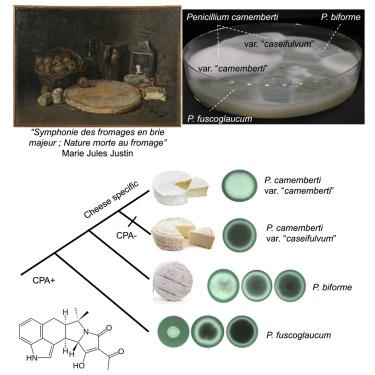Current Biology ( IF 8.1 ) Pub Date : 2020-09-24 , DOI: 10.1016/j.cub.2020.08.082 Jeanne Ropars 1 , Estelle Didiot 1 , Ricardo C Rodríguez de la Vega 1 , Bastien Bennetot 1 , Monika Coton 2 , Elisabeth Poirier 2 , Emmanuel Coton 2 , Alodie Snirc 1 , Stéphanie Le Prieur 1 , Tatiana Giraud 1

|
Domestication involves recent adaptation under strong human selection and rapid diversification and therefore constitutes a good model for studies of these processes. We studied the domestication of the emblematic white mold Penicillium camemberti, used for the maturation of soft cheeses, such as Camembert and Brie, about which surprisingly little was known, despite its economic and cultural importance. Whole-genome-based analyses of genetic relationships and diversity revealed that an ancient domestication event led to the emergence of the gray-green P. biforme mold used in cheese making, by divergence from the blue-green wild P. fuscoglaucum fungus. Another much more recent domestication event led to the generation of the P. camemberti clonal lineage as a sister group to P. biforme. Penicillium biforme displayed signs of phenotypic adaptation to cheese making relative to P. fuscoglaucum, in terms of whiter color, faster growth on cheese medium under cave conditions, lower amounts of toxin production, and greater ability to prevent the growth of other fungi. The P. camemberti lineage displayed even stronger signs of domestication for all these phenotypic features. We also identified two differentiated P. camemberti varieties, apparently associated with different kinds of cheeses and with contrasted phenotypic features in terms of color, growth, toxin production, and competitive ability. We have thus identified footprints of domestication in these fungi, with genetic differentiation between cheese and wild populations, bottlenecks, and specific phenotypic traits beneficial for cheese making. This study has not only fundamental implications for our understanding of domestication but can also have important effects on cheese making.
中文翻译:

标志性白色奶酪制作真菌卡门培氏青霉的驯化及其向两个品种的多样化。
驯化涉及在强烈的人类选择和快速多样化下的近期适应,因此构成了研究这些过程的良好模型。我们研究了具有象征意义的白霉青霉的驯化,用于软奶酪的成熟,如卡门贝尔奶酪和布里干酪,尽管其经济和文化重要性令人惊讶,但人们对其知之甚少。对遗传关系和多样性的基于全基因组的分析表明,由于与蓝绿色野生P. fuscoglaucum真菌不同,古老的驯化事件导致了用于奶酪制作的灰绿色双形假单胞菌霉菌的出现。另一个更近期的驯化事件导致了P. camemberti的产生克隆谱系作为P. biforme的姐妹群。Penicillium biforme相对于P. fuscoglaucum显示出对奶酪制作的表型适应迹象,这些迹象包括颜色更白、洞穴条件下在奶酪培养基上生长更快、产生的毒素量更少以及阻止其他真菌生长的能力更强。该P. camemberti血统显示所有这些表型特征的驯化更加强大的标志。我们还确定了两种分化的P. camemberti品种,显然与不同种类的奶酪有关,并且在颜色、生长、毒素产生和竞争能力方面具有对比的表型特征。因此,我们确定了这些真菌的驯化足迹,奶酪和野生种群之间的遗传差异、瓶颈和有利于奶酪制作的特定表型特征。这项研究不仅对我们理解驯化具有根本意义,而且对奶酪制作也有重要影响。











































 京公网安备 11010802027423号
京公网安备 11010802027423号